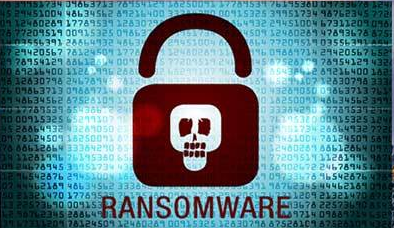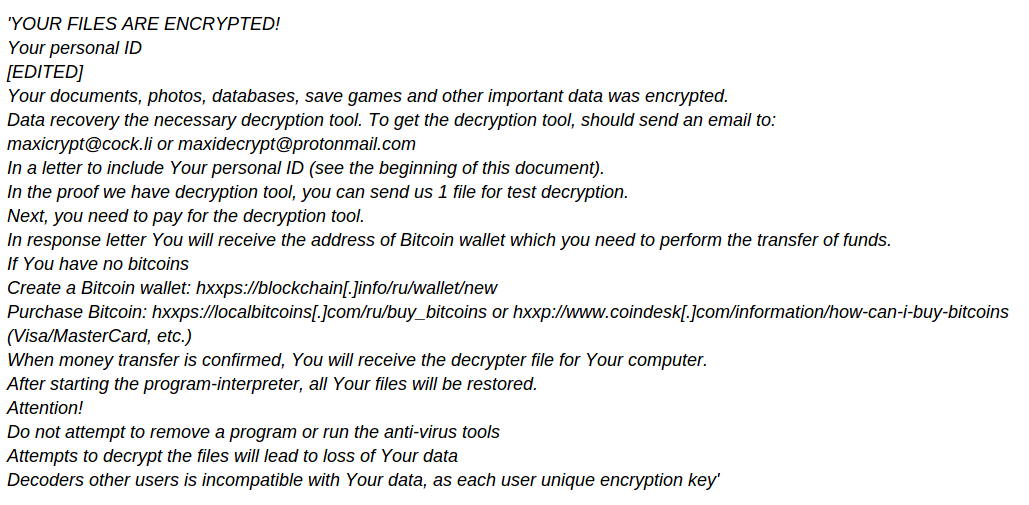MaxiCrypt Ransomware : Latest Investigation Report
MaxiCrypt Ransomware is a latest detection from the malware security researchers on 28th November 2017. It is classed as a middle level Crypto variant malware. This maxicrypt infection has been noticed to infect your systems via corrupted Microsoft documents and malicious emails that contains an infected attachments. Once successfully intrude into your system then it start searching the targeted files and data to follow the data encryption. It uses some of the most strongest AES cipher algorithm to encode the collected data such as spreadsheets, doc files, databases, presentations, pdfs, audios, videos and similar other files. After following successful encryption routine it renames compromised files with ".maxicrypt" file extension and locks them to make it completely inaccessible. According to researchers this uses an email id "[email protected]" to contact with the infected victims to suggesting them to pay the ransom to get the decryption key or software to unlock their files. The malware display a ransom note on the affected system using a simple text titled as "How to restore your data.TXT" and the message contained under it as

MaxiCrypt Ransomware : Threat Analysis
|
Name |
MaxiCrypt Ransomware |
|
Type |
Ransomware |
|
Risk |
High |
|
File extension |
".maxicrypt" |
|
Ransom demand |
$100 in Bitcoins |
|
Distribution |
Spam emails attachments, corrupt or malicious doc files, infected ads etc. |
|
Infected systems |
Windows OS |

MaxiCrypt Ransomware Can Tricks You To Download Attachments
MaxiCrypt Ransomware follows many of tricks to get inside of the system but one of the main source of infection distribution is via corrupted documents which might be send to your system through specially designed spam emails which looks like came from a legitimate organization or a shopping invoice of online website but when you open and download its contents on system then the malicious executable automatically get into it and start running into system background to infect system. Some more ways are through sharing of files on Internet, clicks on suspicious ads or links, visit infected sites and so on.
How To Deal With The MaxiCrypt Ransomware?
As you read above it encipher your files and demand ransom to get the decryption code but you should deny to make payment because they will not help you anyway even after the payment. That's why you should always keep regular backup of your files and be update it daily. Now you should get ready to remove MaxiCrypt Ransomware from infected PC by using a reliable anti-malware. Then after removal run backup to get back your lost files.
Free Scan your Windows PC to detect MaxiCrypt Ransomware
What To Do If Your PC Get Infected By MaxiCrypt Ransomware
The ransomware infection has been mainly designed with the purpose to scare users and trick their money. It take your files on hostage and demand ransom to return your important data. But now the question is what you can do when your system got infected by MaxiCrypt Ransomware virus? Here are some option that you can use to get rid of this nasty infection.
Don’t Panic – Well the first thing is Don’t panic and then completely check out your system for any working files. If you got any working files then copy it to USB drive.
Pay Ransom – Other option is you can pay the ransom and wait to get your files back. (really a bad option)
Use Backup – Clean you entire system files, remove the infection completely from your PC and restore your files with any backup.
Remove Infection – You can also delete MaxiCrypt Ransomware virus using malware removal tool and remove all the infected files. You can later recover all your data by using any data recovery tool. (In case you don’t have backup of your files.) – Recommended Method.
Reinstall Windows – The last option is reinstall your Windows OS. It will completely remove all your data as well as infection. You will get a completely new infection free PC.
How To Remove MaxiCrypt Ransomware Virus From Your PC
Step 1 – Boot your computer in Safe mode.
Step 2 – Remove the infected registry entry files.
- Click Windows Flag and R button together.

- Type “regedit” and click OK button

- Find and delete following entries.
HKEY_LOCAL_MACHINESOFTWAREsupWPM
HKEY_LOCAL_MACHINESYSTEMCurrentControlSetServicesWpm
HKEY_CURRENT_USERSoftwareMicrosoftInternet ExplorerMain “Default_Page_URL”
HKEY_LOCAL_Machine\Software\Classes\[MaxiCrypt Ransomware]
HKEY_CURRENT_USER\Software\Microsoft\Windows\CurrentVersion\Uninstall\[MaxiCrypt Ransomware]
Step 3 – Remove From msconfig
- Click Windows + R buttons simultaneously.

- Type msconfig and press Enter

- Go to Startup tab and uncheck all entries from unknown manufacturer.

Step 4 – Restart your computer normally.
Check your computer now. If the virus has gone then you can start using your computer. If the infection still remains then head to the next step.
Step 5 – System Restore
- Insert Windows installation disk to CD drive and restart your PC.
- While system startup, keep pressing F8 or F12 key to get boot options.
- Now select the boot from CD drive option to start your computer.
- Then after you will get the System Recovery Option on your screen.
- Select the System Restore option from the list.
- Choose a nearest system restore point when your PC was not infected.
- Now follow the option on your screen to Restore your computer.
If the above manual methods didn’t removed MaxiCrypt Ransomware virus then you have only option to remove infection using a malware removal tool. It is last and the only option that can easily and safely remove this nasty threat from your computer.
Having some alarming questions in your mind? Get your doubt cleared from our experienced tech support experts. Just go to the Ask Your Question section, fill in the details and your question. Our expert team will give you detailed reply about your query.




